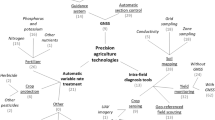Abstract
Previous evaluations of bay (or border check) irrigation in northern Victoria have shown that higher irrigation flows offer very much improved (volumetric) application efficiencies, well above those currently achieved. However, having the correct irrigation duration (or time to cut-off) is critical in reaching those efficiencies. Automation of bay irrigation provides the needed precision in managing the shorter irrigation durations that result from the higher flows. Hence, the objective of the study was to demonstrate the application efficiencies achievable through the use of automated, high-flow bay irrigation. Nine existing automated farms were selected for the trial that together represent the range of soils, bay geometries, irrigation management, and crops typical of the region. A total of 46 irrigations across the various sites were evaluated. Analysis of each event included calibration of the surface irrigation hydraulic simulation model SISCO from the measured flow rate, advance and depth data, and simulation of each event using SISCO to give the required performance parameters. The results from the evaluations demonstrate that application efficiencies in excess of 90 % are indeed achievable and being achieved through correct and precise management of automated surface irrigation. The prime reason for lower efficiency on some farms was incorrect choice of irrigation duration, resulting in significant losses to tail-water run-off. For those farms, strategies to improve performance have been suggested.








Similar content being viewed by others
References
ABS (2008) Water and the Murray Darling Basin: a statistical profile 2000–01 to 2005–06. Australian Bureau of Statistics, Canberra
Bali KM, Grisma ME (2001) Reduced-runoff irrigation of alfalfa in Imperial Valley, California. J Irrig Drain Eng 127(3):123–130
BDA Group (2007) Cost benefit analyses of research funded by the CRDC. Report to Cotton Research and Development Corporation, BDA Group, Manuka, ACT, Australia
Butler BE (1950) A theory of prior streams as a causal factor in the distribution of soils in the Riverine Plain of south eastern Australia. Aust J Agric Res 1:231–252
GBCMA (2012) Farm Water Frequently Asked Questions (FAQs) Round 3: on farm irrigation efficiency program. Goulburn Broken Catchment Management Authority (GBCMA). http://www.gbcma.vic.gov.au/images/201220-faqsr3-september-updated.pdf. Accessed 18 March 2013
Gillies MH, Smith RJ (2015) SISCO: surface irrigation calibration and optimisation. Irrig Sci 33:339–355
Gillies MH, Smith RJ, Williamson B, Shanahan M (2010) Improving performance of bay irrigation through higher flow rates. Australian irrigation conference and exhibition, Sydney, 8–10 June 2010
Hanson B, Putman D (2000) Can alfalfa be produced with less water? In: Proceedings of the California Alfalfa Symposium, Las Vegas, NV, Dec 11–12, pp 43–54
Koech RK, Smith RJ, Gillies MH (2014a) A real-time optimisation system for automation of furrow irrigation. Irrig Sci 32:319–327
Koech RK, Smith RJ, Gillies MH (2014b) Evaluating the performance of a real-time optimisation system for furrow irrigation. Agric Water Manag 142:77–87
Lavis A, Maskey R, Qassim A (2006) Border-check irrigation design. Department of Primary Industries, Victoria, Agriculture Notes, AG1262, ISSN 1329-8062
Raine SR, Bakker DM (1996) Increased furrow irrigation efficiency through better design and management of cane fields. Proc Aust Soc Sugarcane Technol 1996:119–124
Saha R, Raghuwanshi NS, Upadhyaya SK, Wallender WW, Slaughter DC (2011) Water sensors with cellular system eliminate tail water drainage in alfalfa irrigation. Calif Agric 65(4):202–207
Selle B, Wang QJ, Mehta B (2010) Relationship between hydraulic and basic properties for irrigated soils in southeast Australia. J Plant Nutr Soil Sci 174:81–92
Skene JKM (1971) Soils and land use in the Mid-Loddon Valley, Victoria. Technical Bulletin No 22, Victorian Department of Agriculture, Melbourne, Australia
Skene JKM, Poutsma TJ (1962) Soils and land use in part of the Goulburn Valley, Victoria. Technical Bulletin No 14, Victorian Department of Agriculture, Melbourne, Australia
Smith RJ, Raine SR, Minkovich J (2005) Irrigation application efficiency and deep drainage potential under surface irrigated cotton. Agric Water Manag 71(2):117–130
Smith RJ, Gillies MH, Shanahan M, Campbell B, Williamson B (2009) Evaluating the performance of bay irrigation in the GMID. Irrigation Australia, 2009 irrigation & drainage conference, Swan Hill, Vic, 18–21 October
Smith RJ, Gillies MH, Koech RK (2012) Real time optimisation for smart automation of surface irrigation. USCID Conference, Austin, Texas, April 3–6
Smith RJ, Uddin J, Gillies MH, Morris M (2013) Selection of irrigation duration for high performance bay irrigation. CIGR conference on engineering in agriculture, WA, Sept
Uniwater (2008) Regional and economic benefits through smarter irrigation. Final report on STI Project, University of Melbourne
Acknowledgments
Funding for this study was provided by Goulburn–Murray Water. Instrumentation at the trial sites (soil moisture probes, FloodTech depth sensors, and SmartMeter Gateways) was provided and maintained by Rubicon Water. Finally the authors would like to thank the participating growers for providing access to their systems.
Author information
Authors and Affiliations
Corresponding author
Additional information
Communicated by E. Fereres.
Rights and permissions
About this article
Cite this article
Smith, R.J., Uddin, J.M., Gillies, M.H. et al. Evaluating the performance of automated bay irrigation. Irrig Sci 34, 175–185 (2016). https://doi.org/10.1007/s00271-016-0494-8
Received:
Accepted:
Published:
Issue Date:
DOI: https://doi.org/10.1007/s00271-016-0494-8




